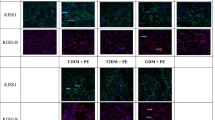Abstract
Postterm pregnancy represents a condition associated with trophoblast apoptosis. Kisspeptin is a peptide able to induce apoptosis by a specific receptor, GPR54, through the upregulation of proapoptotic genes. The aims of the study were to evaluate (1) the messenger RNA (mRNA) expression of kisspeptin, GPR54, Bax/Bcl2, and p21 in postterm placentas and (2) kisspeptin ability to act on apoptosis in the third trimester placental explants. Placental specimens were collected from spontaneous term and postterm delivery and kisspeptin, GPR54, Bax/Bcl2, and p21 mRNA expression levels were analyzed by real-time polymerase chain reaction. Placental explants, collected from elective term cesarean sections, treated with different doses of kisspeptin were analyzed by terminal deoxynucleotidyl transferase dUTP nick end labeling (TUNEL). The expression levels of all the genes studied in postterm placentas were significantly higher than in-term placentas. Kisspeptin-induced apoptosis in placental explants with a dose-dependent effect, and TUNEL assay demonstrated the kisspeptin involvement in the apoptotic placental processes. Our present findings led us to hypothesize that kisspeptin may represent a placental proapoptotic agent acting in physiological and/or pathological pregnancy conditions in which placental apoptosis mechanisms are increased.
Similar content being viewed by others
References
Smith SC, Baker PN, Symonds EM. Placental apoptosis in normal human pregnancy. Am J Obstet Gynecol. 1997;177(1):57–65.
Straszewski-Chavez SL, Abrahams VM, Mor G. The role of apoptosis in the regulation of trophoblast survival and differentiation during pregnancy. Endocr Rev. 2005;26(7):877–897.
Halperin R, Peller S, Rotschild M, et al. Placental apoptosis in normal and abnormal pregnancies. Gynecol Obstet Invest. 2000; 50(2):84–87.
Kotani M, Detheux M, Vandenbogaerde A, et al. The metastasis suppressor gene KiSS-1 encodes kisspeptins, the natural ligands of the orphan G protein-coupled receptor GPR54. J Biol Chem. 2001;276(37):34631–34636.
Bilban M, Ghaffari-Tabrizi N, Hintermann E, et al. Kisspeptin-10, a KiSS-1/metastin-derived decapeptide, is a physiological invasion inhibitor of primary human trophoblasts. J Cell Sci. 2004; 117(pt 8):1319–1328.
Harms JF, Welch DR, Miele ME. KISS1 metastyasis suppression and emergent pathways. Clin Exp Metastasis. 2003;20(1): 11–18.
Beckera JAJ, Mirjoleta JF, Bernardb J, et al. Activation of GPR54 promotes cell cycle arrest and apoptosis of human tumor cells through a specific transcriptional program not shared by other Gq-coupled receptors. Biochem Biophys Res Commun. 2005; 326(3):677–686.
Mc Master MT, Bass KE, Fisher SJ. Human trophoblast invasion. Autocrine control and paracrine modulation. Ann NY Sci. 1994; 734:122–131.
Murray MJ, Lessey BA. Embryo implantation and tumor metastasis: common pathways of invasion and angiogenesis. Semin Reprod Endocrinol. 1999;17(3):275–290.
Torricelli M, Galleri L, Voltolini C, et al. Changes of placental KiSS-1 mRNA expression and maternal/cord kisspeptin levels at preterm delivery. Reprod Sci. 2008;15(8):779–784.
Livak KJ, Schmittgen TD. Analysis of relative gene expression data using real-time quantitative PCR and the ΔΔC(T) method. Methods. 2001;25(4):402–408.
Daher S, Guimaraes AJ, Mattar R, et al. Bcl-2 and Bax expressions in pre-term, term and post-term placentas. Am J Reprod Immunol. 2008;60(2):172–178.
Smith SC, Baker PN. Placental apoptosis is increased in post-term pregnancies. Br J Obstet Gynaecol. 1999;106(8):861–862.
Athapathu H, Jayawardana MA, Senanayaka L. A study of the incidence of apoptosis in the human placental cells in the last weeks of pregnancy. J Obstet Gynaecol. 2003;23(5):515–517.
Kanduc D, Mittelman A, Serpico R, et al. Cell death: apoptosis versus necrosis. Int J Oncol. 2002;21(1):165–170.
Allaire DC, Ballenger KA, Wells SR, et al. Placental apoptosis in preeclampsia. Obstet Gynecol. 2000;96(2):271–276.
Cindrova-Davies T, Yung HW, Johns J, et al. Oxidative stress, gene expression, and protein changes induced in the human placenta during labor. Am J Pathol. 2007;171(4):1168–1179.
Barboule N, Chadebech P, Baldin V, et al. Involvement of p21 in mitotic exit after paclitaxel treatment in MCF-7 breast adenocarcinoma cell line. Oncogene. 1997;15(23):2867–2875.
Caughey AB, Snegovskikh W, Norwitz ER. Postterm pregnancy: how can we improve outcomes? Obstet Gynecol Surv. 2008;63(11):715–724.
Author information
Authors and Affiliations
Corresponding author
Rights and permissions
About this article
Cite this article
Torricelli, M., Novembri, R., Conti, N. et al. Correlation With Placental Kisspeptin in Postterm Pregnancy and Apoptosis. Reprod. Sci. 19, 1133–1137 (2012). https://doi.org/10.1177/1933719112443878
Published:
Issue Date:
DOI: https://doi.org/10.1177/1933719112443878




